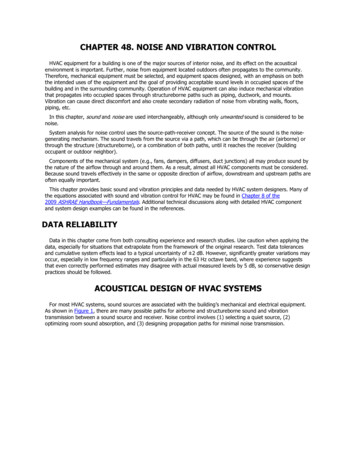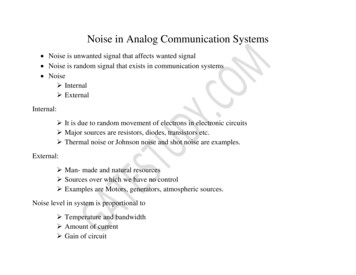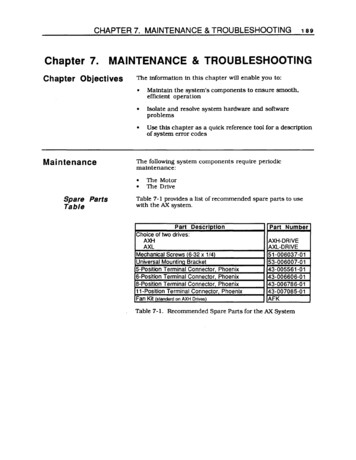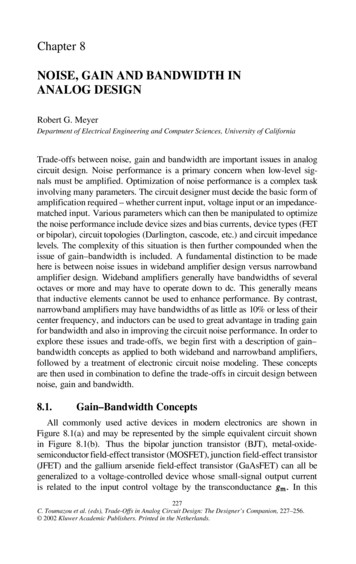
Transcription
The History of Noise[On the 100th anniversary of its birth][Leon Cohen]Noise had a glorious birth. It was one of the three miracles of the miracle year, 1905.Einstein, always aiming to solve the greatest of problems and to solve them simply,saw that noise could be the instrument to establish one of the greatest ideas of alltime—the existence of atoms. In a few simple pages he invented noise, and thus“noise” was born. Immediately after Einstein, there was an incredible flurry ofideas of the most profound kind which continues to this day. Noise permeates every field of science and technology and has been instrumental in solving great problems, including the originof the universe. But noise, considered by many as unwanted and mistakenly defined as such bysome, has little respectability. The term itself conjures up images of rejection. Yet it is an ideathat has served mankind in the most profound ways. It would be a dull, gray world without noise.The story of noise is fascinating, and while in its early stages, noise’s story was clearly told, itssubsequent divergence into many subfields has often resulted in a lack of understanding of itshistorical origins, development, and importance. We try to give it some justice. We discuss whodid what, when, and why, and the historical misconceptions. But most importantly, we aim toshow that the story of noise is an exciting story, filled with drama, and worth telling.IEEE SIGNAL PROCESSING MAGAZINE [20] NOVEMBER 20051053-5888/05/ 20.00 2005IEEE
IMAGESTATEINTRODUCTION TO NOISE“Noise,” as an idea, a subject, a field, an instrument, came uponthe scene with a power and swiftness that transformed all of science and our views of the nature of matter. At birth, it solved themajor issue of its time, perhaps, the greatest idea of all time—theexistence of atoms. The debate on the reality of atoms hadreached a crescendo. The debaters were the greatest of scientists;there was no middle ground, either atoms exist or they do not.The bitterness of the atomists and anti-atomists got extreme, andwhile no one dreamed of seeing an atom, everyone knew theywere debating the greatest of issues:“If . . . all of scientific knowledge were to be destroyed, andonly one sentence passed on to the next generations of creatures . . . it is . . . all things are made of atoms.”—Richard FeynmanAs it turned out, not only do atoms exist, but they are themost exquisite creation of nature; neither the solar system,galaxies, nor anything else can rival the atom’s simple complexity. The 19th century, the century of great achievements—ther-modynamics, electromagnetism, chemistry, and the industrialrevolution—did not need the “atom.” Yet, it was the century ofthe atomist debate, a debate that raged into the beginning of the20th century; until Einstein, always aiming at the greatest ofproblems, and aiming to solve them simply, saw the instrumentto prove their existence! In a few simple pages he invented noiseand thus “noise” was born. This was in 1905. Things movedquickly. Within a few years, Perrin verified Einstein’s main prediction and also his prediction that noise could be used to calculate Avogadro’s number! Avogadro, who came up with one of themost profound ideas of all time, died without any recognition,never dreamed that there would be a number named after him,and certainly he, nor anyone else, could have imagined thatnoise would be the instrument for its calculation and for theawarding of a Nobel Prize.It was the end of the anti-atomists but the beginning of theproud history of noise. Immediately after Einstein, there was aflurry of ideas of the most profound kind that continues to thisday. Within three years, Langevin started the field of stochasticdifferential equations, although that was not his motivation.There were numerous important contributions that laid boththe foundation of “noise” and its application to many fields. Thehistorical twists are fascinating. Who could have imagined thatthe search for atmospheric noise would lead to the discovery ofthe noise at the origin of the universe and establish the “bigbang” theory of the universe?But noise, considered by many as unwanted, and mistakenlydefined as such by some, has little respectability. The term conjures up images of rejection, images of building filters to eliminate it. Yet it is an idea that has served mankind in the mostprofound ways. It would, indeed, be a dreary world without noise.It is now 100 years since Einstein devised “noise.” Noise permeates every field of science, and every field seems to have itsown version of its history. While some fields tell it almost properly, most don’t. The often told version—that Brown discovered,Einstein explained, Langevin simplified, and Perrin verified—isa serious historical distortion. But more importantly, it leavesout the drama and excitement of the story. The story of noise isa fascinating one, but its divergence into many subfields hasoften resulted in a lack of understanding of noise’s true historical development. We try to give it some justice and discuss whowere the main players, who did what, when, and why, and thereasons for the impact on so many fields. But more importantly,we aim to show that the history of noise is a tale worth telling.We hope, though, that we do not say any more than most readers want to know.HISTORY AND SCIENCE HISTORYAlmost every school child since the dawn of school has hatedthe study of standard “history.” Rightfully so, since it is as boring as things can be. In one way or another, we are told thathistory is important. And in one way or another, we are told, asSantayana put it, “Those who cannot learn from history aredoomed to repeat it.” This is certainly one of the silliest thingsever said. Presumably, what is lamented here are the horribleIEEE SIGNAL PROCESSING MAGAZINE [21] NOVEMBER 2005
ETH-BIBLIOTHEK, ZURICHEINSTEIN: WHY HE DID ITthings like wars that we don’t wish to repeat, yet since theEinstein is popularly imagined as a demigod who never changeddawn of history almost all leaders were given the finest ofhis clothing, whose sweaters had holes, who was always immersedschooling in history. If anything, the leaders learned history soin deep thought so advanced that no one could understand him,that they could repeat it. To be fair to Santayana, he also saidwho was always right“History is a pack ofabout everything,lies about eventsEINSTEIN, ALWAYS AIMING AT THE GREATEST OFand whose photothat never happenedPROBLEMS, AND AIMING TO SOLVE THEM SIMPLY,graphs in newspaperstold by people whoSAW THAT NOISE COULD BE THE INSTRUMENTalways fostered thatweren’t there.” ItTO ESTABLISH ONE OF THE GREATEST IDEAS OF ALLimpression. Forgetwould be a newTIME, THE EXISTENCE OF ATOMS.that image and forgetworld, perhaps eventhat Einstein wasa braver one, if weinterested in explaining Brownian motion, the erratic moveadmitted the obvious, as expressed by Huxley, “That men doment of pollen and dust. Einstein was straightforward, direct,not learn very much from the lessons of history is the mostalways clear, ambitious in an honorable sense, and, for whatevimportant of all the lessons of history.”er reasons, conscious or subconscious, decided that he wouldOn the other hand, science history is exciting and inspirtackle the biggest problems and that he would attack them siming. Moreover, it is a great way to learn science. It is truly fasply. Look at a picture of Einstein as a young man, and you willcinating to learn how the greatest of minds came up with thenot see the mythical Einsteingreatest of ideas, and that(Figure 1). Read his writings,makes science history enterand you will see the simplicitytaining. Moreover, it is a factof his motives and desires. Andthat if one is trying to learncertainly his letters, and hisan idea, the originator is thelove letters are of a man whoplace to go. It is often muchknew what he wanted.more instructive to read theSo, again, forget the oftenoriginal papers on a subjectstated notion that Einsteinthan to learn it from a textwanted to explain the erraticbook. If the original author ismovement of pollen in water.a clear writer, which is oftenHe was after proving thatthe case with great scientistsatoms exist! Moreover, he wentand mathematicians, we seeafter the ultimate method thatthe simplicity of their argudefines greatness in science.ments, motivations, and reaPredict an effect, derive a spesons much clearer than incific formula, let the worldsubsequent presentations.perform the experiments, andThis is particularly so in thethere you have it. Einsteincase of noise. If one, forsearched for a manifestation ofexample, wants to get an ideathese invisible atoms thatof what stochastic differentialcould be seen and measured.equations are all about, theSo Einstein said, if atoms exist,original papers of Langevin,then I predict an effect and IOrnstein, Uhlenbeck, andderive a specific formula relatChandrasekhar are worthing to the effect, and if this forhundreds of current books onmula is verified, then . . . !the subject. Moreover, in theWith the courage to say andcase of noise, we havederive it all in a few simpleEinstein, one of the simplestpages, he predicts a macroand clearest writers ever. The[FIG1] Einstein as a young man.scopic manifestation of atoms.introductions, or just the firstWithin a few years, his predicparagraphs, of his papers ortion was proven true and changed the tide: everyone believedwritings are simple, clear, powerful, and fascinating to read.in atoms even though no one saw them.Simply reading them is an incredible education because heIt was 1905 and Einstein’s first Brownian motion papergets to the essence of the subject with remarkable simplicitywas one of the four papers that would constitute the threeand clarity. Fortunately, he left a voluminous amount of writmiracles of the miracle year [1]. The title says it all: “On theings on a wide variety of subjects.IEEE SIGNAL PROCESSING MAGAZINE [22] NOVEMBER 2005
Movement of Small Particles Suspended in a Stationary LiquidDemanded by the Molecular-Kinetic Theory of Heat.” Anothertranslation uses the word “required” instead of demanded.That is, if atoms exist, then small particles immersed in liquidsmust behave in a way to be described and, therefore, if thesmall particles do indeed behave this way, then atoms exist.The first sentence reads “In this paper it will be shown . . . bodies of microscopically visible size suspended in liquid will perform movement of such magnitude that they can be easilyobserved in a microscope on account of the molecular motionsof heat.” Einstein concludes the two-paragraph introductionwith “If the movement discussed here can actually be observed. . . an exact determination of actual atomic dimensions is possible. On the other hand, if the prediction of this motion wereto be proved wrong, a weighty argument would be providedagainst the molecular-kinetic theory of heat.” He concludesthe paper with “. . . the relation can be used for the determination of N; ” N was previously defined as the yet unnamedAvogadro’s number. The last sentence of the paper reads “It ishoped that some inquirer may succeed shortly in solving theproblem posed here, which is so important in connection withthe theory of heat.” That inquirer would be Perrin.There is a book series, put together by Paul A. Schilpp, onliving philosophers and scientists. Each book consists ofcontributed articles, and the living philosopher/scientistgets to reply and comment. All the books in the series aregreat, and the one on Einstein is particularly so. Einsteinwrote “autobiographical notes” in the beginning and a “replyto criticism” in volume two. He starts his autobiographicalnotes with “Here I sit in order to write, at the age of 67,something like my own obituary.” He comments on hisBrownian motion work, which we just described, and endswith “My major aim in this was to find facts which wouldguarantee the existence of atoms . . .”ANNUS MIRABILIS: THE MIRACLE YEAR/THE EXTRAORDINARY YEARThe year 1905 is called the miracle year. Einstein was 26. Thephrase Annus Mirabilis was traditionally applied to the “year”1665/1666, when Newton revolutionized everything in such asustained effort that perhaps miracle is too mild a phrase.Newton was 23. The year wasn’t a year, but about 18 months,but one shouldn’t quibble. It was the time of the plague, and atthe end of 1665, Cambridge University closed officially andNewton went back to his home town. In the subsequent 18months, he revolutionized science and mathematics, inventingmechanics, gravity, light, and calculus, among other subjects,with ideas and methods that seemed to come out of nowhere.Not nowhere, but out of Newton. Of course, he had been thinking about these things before, but at 23, he couldn’t have beenthinking about them for too long. It is no less the case withEinstein’s miracle year, 1905, the year he was working at thepatent office. Of course, he had been thinking about these ideasfor quite a few years, but in his own words, “A storm brokeloose in my mind.”There were three miracles. One of the three is what we nowcall Brownian motion, and the aim was to prove the existenceof atoms. The second was the explanation of the photoelectriceffect, where he introduced the idea of the photon, althoughthe name photon was coined 21 years later (1926) by Lewis,one of the greatest chemists of the last century. The explanation of the photoelectric effect started a chain of events concerning the nature of light, and it was an instrumental ideathat would develop into the new view of matter and light thatwe now call quantum mechanics. The third miracle was thespecial theory of relativity, which totally changed our view ofspace and time and has the consequence that energy and masscan be transformed into each other.The actual number of papers Einstein published in 1905 isfive. All were relatively short, simply written, with a clarity ofpurpose and style that would mark all his papers. Of the threemiracles just mentioned, four of the five papers are directed tothem. They are “On a Heuristic Point of View Concerning theProduction and Transformation of Light” (photoelectric effect)[2], “On the Movement of Small Particles Suspended inStationary Liquids Required by the Molecular-Kinetic Theory ofHeat” (Brownian motion) [1], “On the Electrodynamics ofMoving Bodies” (relativity) [3], and “Does the Inertia of a BodyDepend upon Its Energy Content?” [4]. The answer to the lastone is yes, and of course everyone in the world would get toknow perhaps the most famous equation in history, E mc2 ,except perhaps for F ma.BROWNIAN MOTIONEinstein did mention Brownian motion in his first paper: “It ispossible that the movements described here are identical with theso-called Brownian motion; however the information available tome . . . is so imprecise that I could not form a definite opinion onthis matter.” He began his second paper [5], published a year later(1906), by expressing his regrets: “Soon after the appearance ofmy paper . . . Siedentopf informed me that he and other physicists . . . Prof. Gouy . . . had been convinced by direct observationthat the so-called Brownian motion is caused by the irregularthermal movement of the molecules of the liquid.” We stress,though, it was Einstein who developed the statistical propertiesand got specific results. In the title of the second paper, he usedthe word “Brownian” in “On the Theory of Brownian Movement.”He published a paper [6] in 1907 titled “Theoretical Observationson the Brownian Motion,” in which he gives a review and expresses: “I hope I may be able by the following to facilitate for physicists who handle the subject experimentally the interpretation oftheir observations as well as the comparison of that latter withtheory.” Further, in 1908, he published “The Elementary Theoryof the Brownian Motion” [7]. This paper begins with “Prof. R.Lorentz has called to my attention, in a verbal communication,that an elementary theory of the Brownian motion would be welcomed by a number of chemists.” Einstein then develops theconnection with diffusion in an explicit way. Incidentally, Lorentzwas the greatest physicist of his time. So, after the first paper, thephrase “Brownian motion” became standard.IEEE SIGNAL PROCESSING MAGAZINE [23] NOVEMBER 2005
NOISE, STOCHASTIC PROCESSES AND THEEINSTEIN (WIENER-KHINTCHINE) THEOREMEinstein published many papers on stochastic processes foryears after his original papers on Brownian motion. Whilethere are many reasons for this continued interest, fundamentally his interest in the nature of light, the blackbody spectrum, the so-called Einstein A and B coefficients,Bose-Einstein statistics, and statistical mechanics, amongother issues, all required that he develop new methods regarding noise and stochastic processes. It would take a book to putEinstein’s contributions to noise in proper perspective, butperhaps it is worthwhile to mention that what we now call theWiener-Khintchine theorem, the relation between the autocorrelation function and the power spectrum, was originally doneby Einstein in 1914, years before Wiener or Khintchine. It wasdone in two papers [8], [9] titled “A Method for the StatisticalUse of Observations of Apparently Irregular, QuasiperiodicProcess” and “Method for the Determination of StatisticalValues of Observations Regarding Quantities Subject toIrregular Observations.” That same year, Einstein published anumber of papers on gravitation and relativity. Of course,1914 is the year before the famous 1915 paper on general relativity. We previously mentioned how clear Einstein’s firstparagraphs always are; it is worthwhile to reproduce the firstparagraph of one of the papers just mentioned as it is so relevant to his interest and contributions to signal processing:“Suppose that one observes quasiperiodicaly fluctuatingquantity F as a function of an independent variable t for avery large t-interval T. How can one obtain statistical data of aperspicuous character concerning F for observation? In whatfollows I present a new kind of method by which to attain thisgoal.” By the way, it seems that perhaps it is Einstein who firstdefined the autocorrelation function: “To this end we introduce a quantity χ( ), which we call the ‘characteristic’ andwhich shall be defined as follows:χ( ) F(t)F(t ) 1T 0 F(t)F(t )dt.(1)This equation appears in his notation. So besides originatingthe Wiener-Khinchin theorem, I think it is fair to say thatEinstein also is the one who came up with the autocorrelationfunction. He added that “It will turn out that there exists asimple dependence between the characteristic and the intensity curve;” that is, between the autocorrelation function andthe power spectrum. Einstein then concluded that (leaving outthe constant of integration) 2χ( ) I(x) cos x dx,0(2)where I(x) “shall be called the spectral intensity,” which hederived from the Fourier series in the now usual way. Equation(1) is what is commonly called the Wiener-Khinchin theorem.BROWN AND BROWNIAN MOTIONBrown did not discover Brownian motion, but he studied it seriously, systematically, exhaustively, and passionately. While everyone mentions his 1828 paper, rarely do people mention the title:“A Brief Account of Microscopical Observations Made in theMonths of June, July, and August, 1827 on the ParticlesContained in the Pollen of Plants; and on the General Existence ofActive Molecules in Organic and Inorganic Bodies” [10]. Brief?The article is not brief! It is written in the first person, which wasnot an unusual way of writing at that time. It was common inpapers to see phrases like “I did this,” “I did that,” and “I traveledhere and there.” Of course, the word “molecule” does not meanmolecule in our sense, but it means a small thing. Brown was afamous botanist. At an early age, he gambled and went on an official ship expedition to Australia that lasted about two years. Whilethere, he collected numerous plants that no one had studiedbefore. After his return, he spent years studying these new plants,and for this he earned his reputation. When he wrote the famousBrownian motion paper, Brown was about 45 years old.Brownian motion was discovered in the early days of theinvention of the microscope. With the invention of the microscope came the discovery that a drop of pond water contains anincredible world of microscopic life, single-celled and multicelled organisms of incredible varieties. Most of the organismsmoved about seemingly without rhyme or reason. In the hundreds of years since its invention, the microscope has kept manykids glued to it, mesmerizing them with an amazing world.Anyway, it was noticed that other things like pollen also haderratic movements, and yet they seemed very different than theobviously live paramecium, amoebas, and such. But could theseerratic movements of pollen indicate that they are alive andkicking; could they be the most primitive life yet? Many thoughtthat these erratic movements were possibly due to some primitive life force. Brown saw the huge stakes in answering thisquestion and went all out. He started with the usual pollen andthen went through an incredible number of materials that areobviously not alive. “Having found motion in the particles of thepollen of all the living plants which I examined, I was led next toinquire whether this property continued after death of the plant. . . either dried or immersed in spirits for a few days only, theparticles of pollen . . . were found in motion equally evident withthat observed in the living plants.” Brown even studied driedplants “no less than a century” old. He also studied minerals andwoods of all kinds, as well as anything else he could think of.Everything demonstrated the erratic movement. After a while,he said “To mention all the mineral substances in which I havefound these molecules, would be tedious.” It may be tedious, buthe basically did mention all of them! Thus, he concluded thatthe erratic movement is not due to some life force.THE SECOND BROWN ARTICLEBrown actually wrote two articles concerning Brownian motion.The second one [11], called “Additional Remarks on ActiveMolecules,” is written “to explain and modify a few of its statements, to adver to some of the remarks that have been made . . . .”IEEE SIGNAL PROCESSING MAGAZINE [24] NOVEMBER 2005
imagined. That these atoms can combine to form molecules, creatMostly he wanted to make sure that “. . . an erroneous assertioning substances whose properties are so dramatically different thanof more than one writer, namely, that I have stated the activethe original atoms; that we can combine gases to form water; poimolecules to be animated” does not go down in history; he cersons to form salt; and that there seems to be no end to the varietytainly did not want to go down in history as someone whoof molecules, is certainly something that no one could havethought they were alive! He also made clear that his experidreamed about.ments aimed to show his “beliefThe possibility that matter,that these motions of the partiOF THE GREAT SCIENTIFIC DEBATES,clearly perceived by our sensescles neither arose from curTHE EXISTENCE OF ATOMSas continuous, is really comrents in the fluid containingRANK AMONG THE VERY TOP.posed of discrete objects beganthem nor depend on the intesto enter serious thought aroundtine motion which may be supthe early 18th century. Theposed to accompany itsoriginator was Bernoulli. But wait, what about the standard lineevaporation.” He goes on to make clear that we do not know thethat Democritus, the laughing philosopher, conceived of thecause, and he hopes future experiments will “ascertain the realidea of atoms? Take his ideas for whatever you want, but it wascause of the motions in question.”not science. Democritus explained nothing with it, and it wasone idea among numerous ones that turned out to have someWHO DISCOVERED BROWNIAN MOTION?semblance to reality. We forget all the other nutty ones arrivedAt the end of his second article, Brown clearly wanted to corat by pure speculation. One of Democritus’s ideas was thatrect his lack of proper review of the literature: “I shall concludeatoms are indivisible. So much for speculation. Aristotle madethese supplementary remarks to my former observations, byfun of the idea, and it was forgotten until someone thousands ofnoticing the degree in which I consider those observations toyears later remembered him. In the words of Jeans [12], “Givenhave been anticipated.” He went on to mention that it seemsthat a great number of thinkers are speculating as to the strucLeeuwenhoek, the inventor of the microscope, probably sawture of matter, it is only in accordance with the laws of probabilBrownian motion. He also named many scientists who studiedity that some of them should arrive fairly near the truth.”Brownian motion and gave a brief account of his predecessors’In 1738, Bernoulli did have a scientific reason for inventingactions. The names are Gray, Needham, Buffon, Gleichen,atoms and did explain something with them. Boyle, some 70 yearsWrisbur, Muller, Drummond, Bywater, all are essentially forgotearlier, had shown that air exerts pressure and that it is inverselyten, so we might as well mention them here.related to volume. So the question became: How come? How doesAfter Brown, the possible causes of this erratic moveair exert pressure? Boyle himself came up with the explanationment were studied. Many possibilities were suggested,that, somehow or other, particles repel each other; Newton and othincluding vibrations, temperature fluctuations, light, surers took up this idea. Newton developed the “repulsion theory” of aface tension effects, and electricity. It was 1880 whengas and combined it with the then-prevailing idea that heat is aGeorges Gouy, a French physicist, saw everything clearly.fluid. Bernoulli, on the other hand, saw clearly that if the gas conHe was an experimentalist and did careful experiments thatsists of little balls, then pressure arose from the force with whichcould leave no doubt that the erratic motion could not bethey hit the sides; he derived Boyle’s law using this idea. That is thedue to external effects. He argued that it was some inherentderivation we now see in elementary physics and chemistry books.property of the fluid that was causing the motion, and heBut no one took any of this too seriously; if anyone did worry aboutproposed reasons that were very close to the truth. In fact,atoms, it was with the Boyle-Newton idea, not with Bernoulli’s idea.he argued that it was a direct reflection of atoms. Thus, heclearly had the idea before Einstein, but he did not work outLAVOISIER, DALTON, AND AVOGADROthe concrete results that Einstein did.Nothing much happens until the end of the 18th century andthe beginning of the 19th century. Lavoisier, lawyer turnedTHE ATOM AND RANDOMNESS:scientist, revolutionized almost all previous thought about theA QUICK HISTORY TO 1908nature of matter. Forget all that fluff of the past 2,500 years—Of the great scientific debates, evolution, the age of the earth, thethe earth, fire, air, water, view of nature—he said. Forget aboutcentral position of the sun, the existence of atoms rank among theearth, fire, air, and water as the four fundamental, indivisiblevery top not only because of the central question of their existence,elements of which everything is composed. He came up with thebut because of the peripheral issues, among them, the frighteningrole of oxygen in combustion and explained what fire really is,thought that thermodynamics, the science dealing with the mostand, as to the idea about the fundamental indivisibility of water,fundamental principles, is mere statistics. The history of the atomhe decomposed it! He came up with conservation of mass instarts slowly and builds into a story of the greatest magnitude untilchemical reactions and numerous other ideas that are now stanthe early part of the 20th century when it is resolved, althoughdard and which caused a revolution in human thinking. But henobody “saw” an atom until many years later. Atoms, historicallydid not pay attention to the real revolution, and had his head cutspeaking, started structureless but turned out to be incrediblyoff because he once had the job of collecting taxes.structured objects with a beauty and depth that no one could haveIEEE SIGNAL PROCESSING MAGAZINE [25] NOVEMBER 2005
One of Lavoisier’s great achievements was to understand thatwhen substances react to form new substances, they do so ingiven mass proportions. This was the start of modern chemistryand, in particular, stoichiometry. But why should things alwaysreact in the same way? That question is what led Dalton, in 1803,to propose “atoms.” He understood, in rough terms, that if thereare atoms and these atoms react to form new substances that arefixed combinations of atoms, then substances must react in givenproportions. At about the same time, Gay-Lussac came up withstudies of how things combine when the volumes of the reactinggases are considered. Facts were catalogued but not understood.Enter Avogadro. In 1811, he came up with the key dramatic ideathat could clarify everything. He argued that everything becomestransparent if we just assume that, in a fixed volume, the numberof little balls of a gas is the same for all substances, no matterwhat the mass, the size, or the exact nature of the substance. Takea liter, fill it with any gas you want, and it will have the samenumber of balls, Avogadro said, and if you keep that in mind, thenhow and why things combine to form molecules becomes easilyunderstood. This was the birth of Avogadro’s number, except forthe fact that he wasn’t taken seriously, died lonely and unrecognized, and nobody named his number for many years. As we willsee, noise helped restore him to his rightful place in history. Thisis crucial to the story because, indeed, Einstein and more particularly
important of all the lessons of history." On the other hand, science history is exciting and inspir-ing. Moreover, it is a great way to learn science. It is truly fas-cinating to learn how the greatest of minds came up with the greatest of ideas, and that makes science history enter-taining. Moreover, it is a fact that if one is trying to learn











